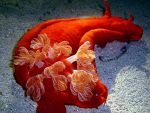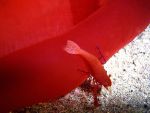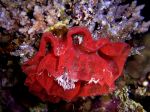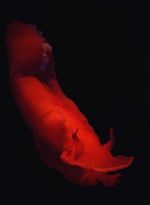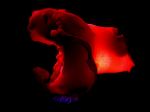Articles
Spanish dancer
11-10-2008
Red dress with white stripe are waving in rythm flamenco. Typical rytmic and movements and dynamic stamping go with beautifull gesture of spanish dancer. Everything is full with passion and elegance. Everybody can´t breath, dancing is not over. Everybody, even me want to see show like this. But is not dancer as dancer. Maybe more beautiful and rare sometimes appears in dark night. Waves of ground sea, dark darkness and typical ,,red dress“. Before me is gorgeous nudibranch.Spanish dancer (Hexabranchus sanquineus) is really one of the most famous nudibranchs. Many divers, and mainly photographers wish to see this beauty. It has six pairs of branches. It´s colour (red with white stripe) and abillity to swim with graceful undulation gives it the nickname spanish dancer. I am slowly going near , I can´t breath. I am wishing that hexabranchus will dance. And really, my dream is coming true. It elegantly goes from reef, strechs it´s body and starts to ,,dance“. It is waving and moving whole body, sometimes you could see the white stripe. As really is dancing dancer of flamenco. I am petrified and I watch fascinated this amazing creature. It is not a small animal like others from family of nudibranch, this one can be 40cm long. It has also some interesting various colours, it was thought that are many species, but in 1972 T.E.Thompson said that it is one specie. It appears in Red sea, Arabic sea and Indopacific areas. Hexabranchus is hermafrodit, it means that it has male and also females glands. Orangebrown eggs it leaves on reef without any care. Sometimes I find some during diving. After some time a veliger plankton larvas are born from eggs (it is type of larva in molluscs family with velum and chitinose shell). Few times I met ,,spanish dancer“ before dask, but it is mainly night animal. It eats sea sponges which give to hexabranchus bad taste for others animals. By it´s colour warn potencional predators that it is not good to be eat. But for one ,,hunter“ is this warning not useful- for photographs. I am trying to catch this dance, but I have no luck. Dark and really fast moves of ,,dancer“ finished my trying so after few photos I am just watching this show. It is really magic. Unfortunately after few minutes the dance ends. ,,Dancer“ put together dress adn slowly descent to the sandy bottom. It falls lightly on sand between coral towers, and again strech to it´s full size and continue again in it´s way. I am observing the white branches. Suddenly I see a move. What is it? I look close. There are two red shrimps. I never saw them before on hexabranchus. I am watching how they run on their hostile. Up to the rhinophores and back, going down under hexabranchus and they are very acctive. This shrimps (Periclimenes imperior ) I saw before on sea cucumber. Shrimps eat slime and excrements, they have cleaning function. They are 2cm long and they are well camouflages by colour, they stay on hexabranchus even during swimming. I am trying to take photo of them but this little ones can´t be catched by my camera. I am capitulating and changing to clear watcher biologist. Hexabranchus crawls on sand, shrimps continue in their work. This symbisis is good for both off them. Shrimps are protect and hexabranchus is clean from parasits. Wish someone could care about us like that.
The time is over. I have to say good bye to this magic creature. Whole night dive I was on area 10x10m, but it was unforgettable dive. Every time you see something what is rare is worthy to stop by and watch this beauty. Red point is dissapearing slowly in dark. Just my torch lightly light on hexabranchus. Maybe I will see you dance next time.
back


